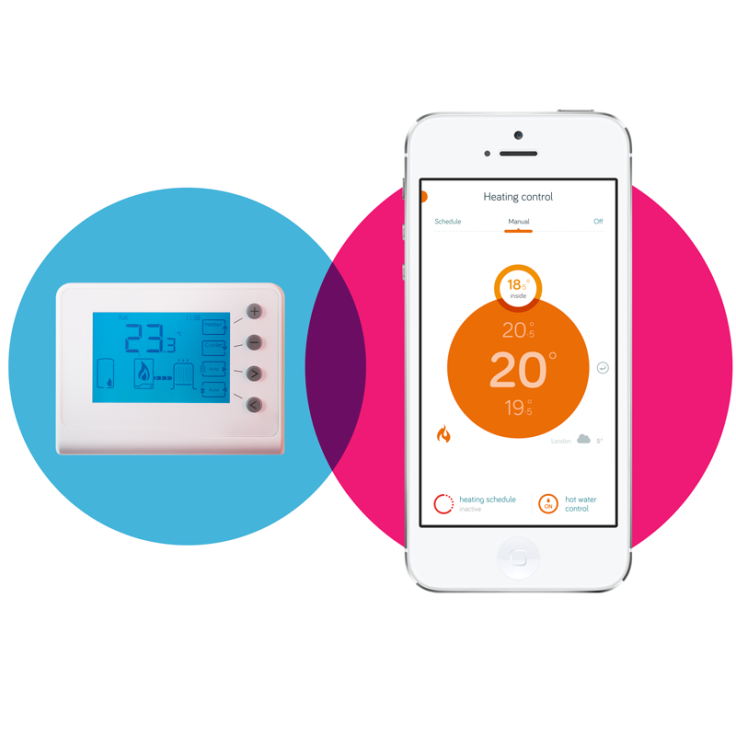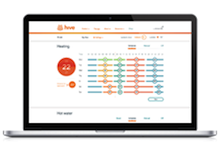Nest Protect, Philips Hue and British Gas Hive: The Home of the Future is Here Today

I still remember the presenters of Tomorrow's World telling me in the late 1980s that I would soon be able to control everything in my house from anywhere in the world.
Everything would be connected, and everything would work together in seamless harmony.
It is more than 20 years later and my childish hope and enthusiasm has given way to cynicism and despair that that utopian future may never arrive.
I've been to the International Consumer Electronics Show in Las Vegas for the last four years and each year have heard the carrion cry of manufacturers like Samsung and LG telling me that the future is here and everything is now connected.
Fragmented and piecemeal
But no matter what these electronics giants tell me, I know that unless I buy my oven, fridge, washing machine, smartphones, tablets and laptops all from a single manufacturer then my home will not be connected.
And that still leaves my lighting, my heating, and numerous other parts of my home unconnected.
The truth is that home automation is here, but in a fragmented, piecemeal way.
I have already looked at the premium end of the home automation market, with a smart apartment crammed full of cutting-edge (and bank account decimating) technology to allow you control every aspect of your home life from an iPad.
But what about the rest of us? What technology is out there now that we can use to make our everyday lives that bit easier?
i decided to try out three piece of technology which are relatively affordable to see if they work, and more importantly, if they made my life any easier.
Nest Protect - the smart smoke alarm
Nest has been in the news a lot recently after it was revealed that Google had purchased the smart home appliance company for $3.2 billion.

Nest's first product to go on sale in the UK is the Protect, a smart smoke and carbon monoxide (CO) detector which aims to replace the annoying box you wave a tea towel at when you burn the toast with something altogether more sophisticated.
Nest is the brainchild of one of the men credited with creating the iPod, Tony Fadell, and so unsurprisingly design is one of the big selling points of Protect.
Yes it costs an arm and a leg compared to most smoke detectors (£109 versus £20) but the build quality is immaculate and the I would go as far as saying it will almost be seen as a piece of art on your wall.
Set-up is relatively painless (though the first review unit I got had to be sent back as it kept resetting itself). Simply download the Android or iOS app to your phone, pull out the tab on the rear of the Protect and sync the two.
You tell the app which room you are placing the detector in and once you have mounted it on the wall using the accompanying bracket, you are all set.
The genius of the Protect is that, rather than emitting a loud screech which you can't quieten, it will give you a gentle warning that something is wrong, which you can dismiss with a wave of your hand in front of the unit, by pressing the large central button on the unit or from your smartphone or tablet.

The circular glowing light also acts as a nightlight guiding you around your home in the dark, removing the need to turn on the main lights when you get up in the middle of the night to go to the bathroom.
The system works well, though the alert to my smartphone when the alarm went off was quite delayed, which could be a major issue in case of a serious indicent.
Otherwise the Nest Protect, which also acts as a CO2 meter, is a vast improvement on the traditional smoke detector, removing the annoying aspects while maintaining all the safety aspects.
Philips Hue Lightbulbs

Probably the one part of this experiment I was least enthused about, Philips Hue is a smart lightbulb which allows you to change its colour, increase/decrease its brightness and turn it on and off all from your smartphone or tablet.
Admittedly it's not an earth-shattering idea but there is more to Hue than first meets the eye.
Setting up Hue is straight forward. Plug the Bridge (supplied in the Starter Pack) to your router and using the app on your iOS or Android device, you can connect to your bulb(s).
The problem is that the bulbs only come in two sizes (GU10 and E26 screw fitting), meaning that if your light fittings aren't suitable, you can't use the bulbs without chaing the fittings themselves.
The range of colourful lighting effects you can create is pretty much endless, allowing you to completely change the mood of a room, depending on where you want to work or relax.
I found the Philips Hue bulbs are not as bright as regular bulbs, and at times they were slow to respond to changes, taking up to five seconds to change colour after I tapped the app.
One feature which isn't immediately obvious is being able to use the Hue lightbulbs as an alarm clock, setting the timer to gradually brighten over the course of nine minutes in the morning.
For the security conscious, Philip Hue bulbs can be controlled even when you are no where near your home, meaning you can turn them on and off while you are on holiday to deter potential burglars.
The bulbs are expensive however. The starter pack costs £180 with additional bulbs costing £50 each but considering they use 80% less energy than traditional bulbs and last for 15 years, you will probably save money over the lifetime of the bulbs.
British Gas Hive
As energy costs continue to rise, everyone is becoming more and more aware of exactly how much they are spending on heating their homes.

Along with the price of oil, gas and electricity, the other major factor in your energy bill is waste - having the heating on when it's not needed, heating your home too much or incorrectly scheduling the heating to come on even when you're not there.
To solve this problem we have smart thermostats. Nest, the company which produces the Protect smoke detector, has one which is on sale in the US at the moment but not in the UK.
Hoping to capitalise on the growing popularity of the connected home, and people's desire to lower their energy bills, British Gas has launched it's own smart thermometer called Hive.
It costs £200 for the equipment and installation but British Gas says it will save the typical house £150-a-year in heating bills. I can't really comment on this having used the system for just two months, but I do think I'm using my heating much more effectively.
The system requires you to infall a receiver on your boiler and connect a hub to your router. This allows you to control your heating system from anywhere in the world via the Hive website or the Hive smartphone/tablet app.
You also get a wall-mounted console in your house which displays the current temperature and will allow you control the system even if your Wi-Fi network crashes.

The app (iOS or Android) gives you three main options - Schedule, Manual or Off. You can set the schedule for the whole week and just leave it on this option if nothing is ever going to change with your routine. It removes the problem of having to remember to turn your heating on or off.
While you can set the schedule via the app, it's a much easier task to do so on the Hive website where you move sliders around to set your schedule.
If you switch to Manual it will override the Schedule settings and let you turn the heating up or down if you come home early from work or switch the heating off if you are delayed. It also means you can turn the heat on when you leave the pub so your house will be warm by the time you get home.
The system works brilliantly, and the simple feature of being able to turn the heating off from bed using your smartphone, and not have to traipse all the way back to the boiler, makes it worth the money on its own.
Conclusion: Connected or Disconnected?
The connected home of the futrue that I was promised as a wide-eye youth is not here and will problably never be realised in the way it was in my imagination. However, we are slowly but surely moving towards having our homes converted into smart homes by devices like Nest Protect, Philips Hue and Hive.
The space is very fragmented and the devices are still relatively expensive, but in the long run will undoubtedly save you money. As more and more players enter the space the cost of these products will fall, and then we will begin to see the widespread adoption of connected technology.
The industry will likely adopt a standard for smart, connected technology at some point and then we will begin to see the exponential growth of the sector, but for now, the fragmented nature of the market can still make your life that much easier.
© Copyright IBTimes 2025. All rights reserved.






















